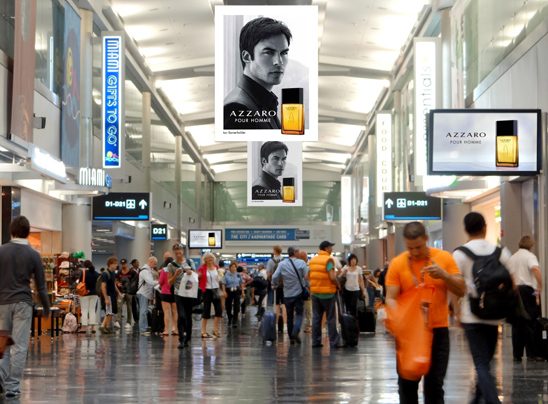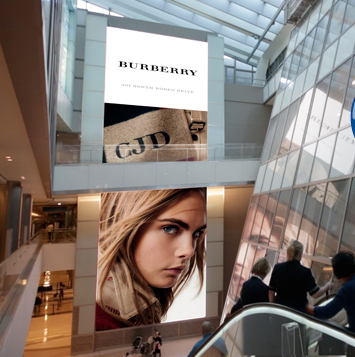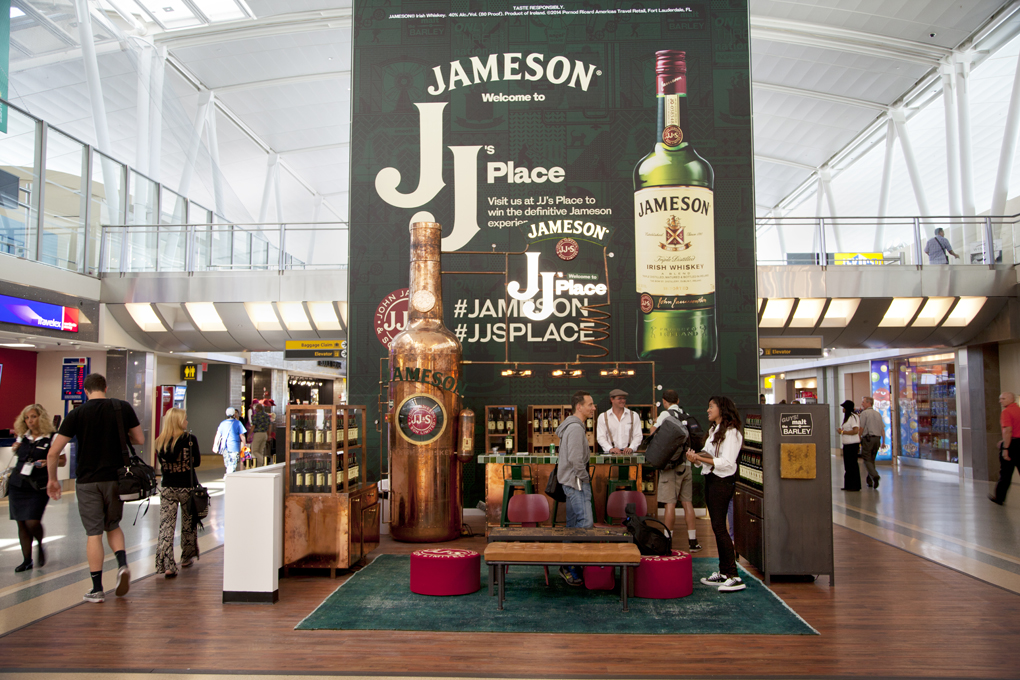Jean-Luc Decaux, Co-CEO of JCDecaux North America, tells TMI how his company’s cutting edge campaigns are able to capture the attention – and pocket book – of the traveling public. Lois Pasternak reports.

Passengers at Miami International Airport were surrounded by banners and visuals for the Azzaro Pour Homme fragrance last summer, leading to a huge increase in sales at the duty free store.
Travelers arriving in Los Angeles Airport’s Tom Bradley International Terminal at the end of last year were treated to the jaw-dropping spectacle of a 300 foot high digital Welcome Wall playing a full motion video of British beauties Cara Delevinge and Kate Moss in their Burberry trench coats in the campaign for the My Burberry fragrance. Burberry was the first digital media sponsor to use TBIT’s new super screen that greets passengers in the brand new remodeled terminal.
At the other end of the country, passengers at Miami International Airport last summer were guided right to the point of purchase at the Duty Free shops by a banner and digital campaign for the Azzaro Pour Homme fragrance. Over the 4-week period that the campaign ran, the brand saw a 43% increase in sales in July and a 76% sales increase in August at the Duty Free Americas stores, and more than 120% increase in brand awareness, according to JCDecaux, the global leader in airport advertising, who ran both campaigns.
“We are the largest media operator at airports around the world, with campaigns in more than 150 airports,” Jean-Luc Decaux, co-CEO of JCDecaux North America tells TMI during an interview that, fittingly, took place at MIA. “When you add up the audience of our key airports around the world, it’s about one-third of the global travelers. We control pretty much the biggest airports in the world from Paris to London to New York to LAX to Beijing. These are the biggest platforms that we have,” says Decaux.In North America, JCDecaux has concessions in 24 airports including the big 3 of international travel: John F. Kennedy, Miami International and LAX. The company says that it reaches 512 million passengers a year in U.S. airports, delivering one of the highest concentration of business passengers and frequent fliers in the industry.
“Even business travelers have to be in the airport an hour and twenty minutes before their flight. This is where we capture them and this is what makes our medium so unique. Basically, we have all of these people that are predisposed to be exposed to the advertising message and go and shop in travel retail stores because that’s all they have to do,” says Decaux.
JCDecaux is by far the most experienced developer and operator of advertising displays across the country. Last year, the company celebrated its 50th anniversary and the transit division, which covers airports, is only one of three segments of its business.
“Our original business is our street furniture segment, which is all the bus shelters, advertising pillars, freestanding units, any sort of outdoor advertising that provides a service to the city. We invented the concept of the bus stop shelters back 50 years ago. Now we’ve got street furniture contracts in more than 1,200 cities around the world,” he explains.
Billboards make up the second segment of JCDecaux’s business. “We are the largest billboard company in Europe and in the U.S. We are just starting our first venture in Chicago, with a very unique plan to build 60 brand new digital large format billboards on the four major expressways getting in and out of the city. It’s a pretty unique partnership because it’s the first time we have a private partnership with the city.
In all three segments, JCDecaux is bringing people something new and exciting, right where they are.
“Every time someone goes to the airport, it’s almost like a different experience. Working with our advertisers, whether it’s travel retail or not travel retail, we are trying to make the medium be much more engaging, much more experiential,” says Jean-Luc.

Luxury brand Burberry was the first commercial media sponsor to use the 300-foot high digital Welcome Wall at the new Tom Bradley International Terminal at LAX.
“The trend started a little earlier in the European airports than in the U.S., but we are working with our U.S. airport partners to develop new concepts. The primary role of the airport is to move people from A to B, the rest is secondary. But airport officials also understand that people are in the airport for a long time and if they can give the passengers an exciting experience, it makes their journey more enlightened.”
The airport projects underway throughout the U.S. can provide new opportunities for creating engaging programs, says Decaux.
“LAX was a major development, and a prime example of how the venue, the space, the architecture, the retail experience, give us more possibility to allow the brand to really convey a message in different manners. We are finding that the brands are very excited to be in this airport, because they understand the exclusive audience there, an audience they find very difficult to capture with other media.”
JCDecaux has conducted quite a few experiential exhibits—some of which are pop-up stores — for spirits companies such as Pernod Ricard, Bacardi and Diageo.
Working with alcohol can be very complex, he says: “They have to have a liquor license, and every state is going to be different. But the more case studies they have, the better story it makes.
“The brands are doing a very good job developing these exhibits, making them very unique, very stylish,” says Decaux. “They almost look like a permanent display. Obviously it’s very important to them and for the brand perception. It is also important for the airport when people look at an activation and go, Wow!”
Over the past year, JCDecaux has been involved with pop-up stores for such brands as Chivas, Jameson, and Haig Club, to name a few.
“We started using the pop-up stores 4 or 5 years ago, and have been doing more of them over the last couple of years, thanks to the good work that Glorimar Figueroa, our National Sales Executive /Airport has done in travel retail. The very first example of an exhibit was probably the Bombay Sapphire fish tank, which was pretty unique. But that was pre 9/11, so it didn’t matter where you were in the airport. Most projects were pre-security because you would fly through security just like that. Now, all that has changed. Exhibits have to be post-security,” he says.
“One of the key elements of these experiential exhibits is the sampling. This gives the brand an opportunity to allow people to try your product. Cosmetics is easy because it’s a little spray, but giving away alcohol in the airport? The first time it was approved I was surprised but with picture IDs, and boarding passes, everything is controlled.”
The need to be post-security has created more challenges in transforming from a static display into an experiential activation, Decaux explains: “You need people with badges for the construction, and to bring in the equipment and the liquors, plus other challenges. But when completed, you have exhibits where people can sit down, talk to an ambassador of the brand, and sample the product.”
Decaux says that the best campaigns inform, entertain, and create a demand for the product: “In the last exhibit that we did for Jameson, the passenger got a sample of the drink, and if he bought a bottle in the duty free store, he came back to the exhibit and we gave him special Jameson whiskey glasses. Pernod Ricard really understands the dynamic.”
JCDecaux gets requests for special projects from big corporations looking for something very unique in the airport.
“At JFK in Terminal 1, about 2 years ago, LVMH approached us with a very specific brief. They were looking for a very iconic digital large format screen at JFK to be an ambassador for most of their brands, and at the time we did not have any signs as big as what they wanted. So we worked with them and walked the entire airport looking for a location, and created something that really met their objectives,” explains Decaux.
Not all of JCDecaux’s memorable airport projects involve digital campaigns or transportable store fronts, he says.
“Sometimes, the simplest ideas are the best, but you have to come up with that simple idea. About 5 years ago, when everyone was becoming more and more dependent on their ipads and tablets and laptops and cellphones, you would see people all over the airport sitting on the floor, to find what I call the ‘vacuum cleaner plug’ in order to charge their device. Even business people were sitting on the floor in suits, trying to recharge. And we realized that there was definitely a need for people to plug in.
“So we created the mobile charging stations, and we sold Samsung on the idea, and partnered with them for a number of year (in the last six months, the partnership has been taken over by Verizon). Over time we revamped and the units; now it has a USB charger, regular plugs, and other technologies and a digital screen inside so we can run digital advertising. It’s the next generation, but the need is still there.
“You always have to reinvent yourself, reinvent the design, and make it much more dynamic. This is very much the approach that we started out with our street furniture business, because the whole idea was to serve the people on the streets, make the journey more pleasant, provide a shelter while they wait for the bus.
“In the airport, the idea is also to find those ideas that improve the passenger experience. That, to me, is the best example of a media company thinking beyond just putting a sign on the wall, by saying, “How can we make our story more relevant?”
In fact, JCDecaux has been in the forefront of many of the airport advertising innovations, ranging from introducing large format ceiling-suspended banners in U.S. airports to the now ubiquitous Jet Bridge branding. TBIT’s giant digital Welcome Wall is just the latest in a long line of iconic creations.
What does Jean-Luc see for the future?
“Travel retail experiences are getting more and more sophisticated. The exhibits that our partners are building are becoming more digital. A lot of them are manned but many have digital components as well, with a touchscreen that allows the consumers to interact. People are getting much more familiar with technology and that’s a big part of the experience.
“The biggest categories are still cosmetics and alcohol. Confectionery is another category that we see developing customer engagements. Jewelry and watches are not so big although we are working with Rolex for the clock sponsorship program at JFK and LAX.
“We have been in business more than 50 years now, and started our international expansion probably after ten years. Once we were well established in France we expanded into Portugal and Belgium. After we started developing the billboards, we expanded mainly in Europe. In the last 15 years, we began to expand on a global basis, including Asia and the USA. Since then our growth has taken a big turn. It’s very exciting. The world is big and there’s still plenty of things to be done.”

JCDecaux presented Pernod Richard with its 2015 award for the Best Campaign for Experiential in Airports for the Jameson campaign run in New York JF Kennedy International Airport and Miami International Airport last year. The activation had also been run in several European airports, according to Erwin Maldonado, VP Marketing at Pernod Ricard Americas Travel Retail.
“The Jameson campaign we ran with JCDecaux was the most successful Pop-up for Pernod Ricard in terms of the number of visitors, tastings and digital noise that it created among consumers,” Maldonado tells TMI. “This Pop-up is a clear example of not only image but an engaging experience looking to entertain the passenger while they wait for their flights.
“As a company it’s always motivating to get the recognition for your brand activations and an award is certainly a great recognition. Coming from such a prestigious partner as JCDecaux reinforces the job that Jameson is doing in looking for innovative ways to entertain its traveling consumers.”










